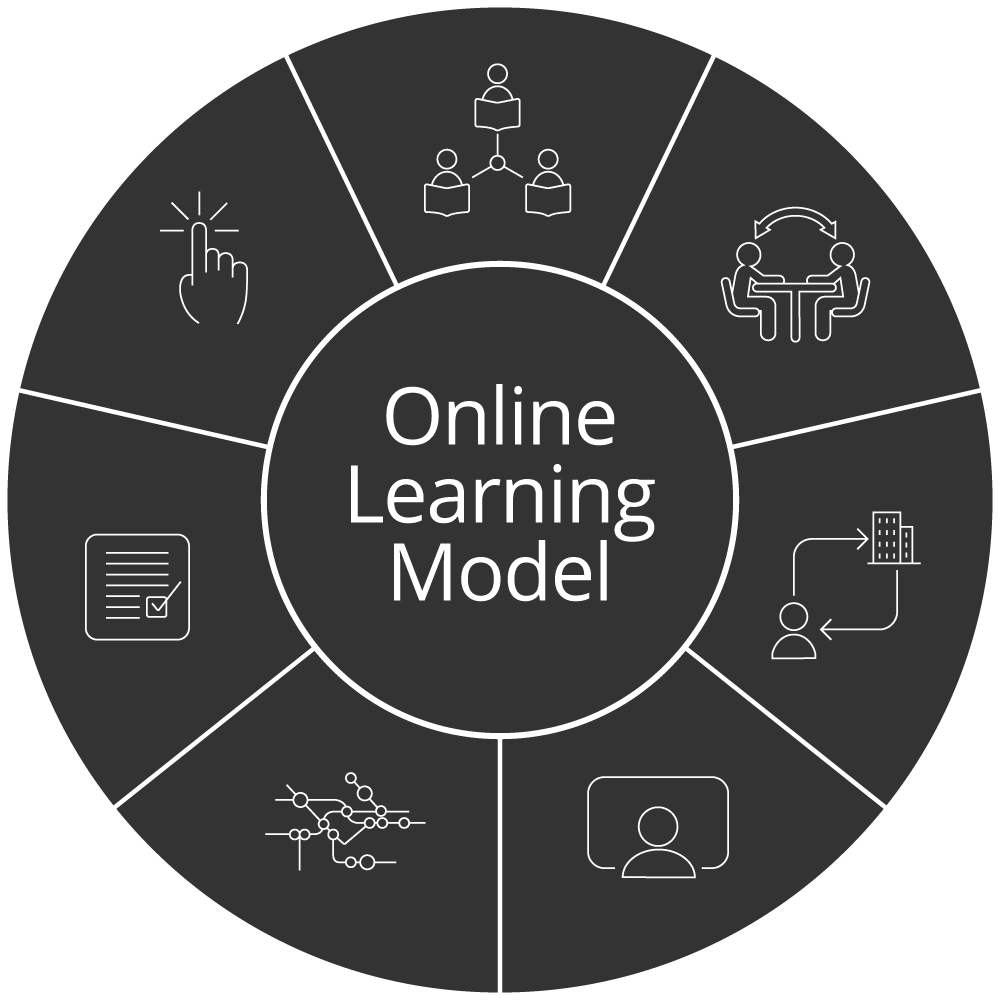The Online Learning Model can help you plan you online teaching to increase student engagement, retention and satisfaction.
The Online Learning Model (OLM) consists of seven elements designed to increase student engagement. The elements can be combined together in varying degrees within a subject.

Each element in the model suggests different ways to include interaction between:
As you include activities that include different types of interaction, you increase the opportunity for students to engage with the content and learning you are offering.
You are a key influence on the way that students engage with learning in your subject. Your passion, knowledge and skills improve student confidence in their ability to learn and capture their interest in the topics. Regular online communication provides students with support and your availability in responding to questions and comments builds a learning relationship that keeps students engaged. Teacher presence can be completed as both synchronous and asynchronous activities.
Students learn from each other and support each other to understand. Peer learning means they can ask questions, clarify their understanding, check-in and create ideas together. It builds a sense of belonging and supports retention. You can plan learner-to-learner engagement as both synchronous and asynchronous activities.
Feeling part of and actively contributing to a learning community is directly linked to student motivation and resilience. Studying within learning groups can be an important foundation for effective interaction between students, their peers and teachers in support of deeper learning. Proactive support from teachers for learning within smaller groups, provided synchronously or asynchronously, is important if the benefits of intellectual rigour and deep engagement are to be achieved.
Online cohorts of students come with diverse backgrounds and lifestyles and want to feel that they can access their learning when it best suits them. Technology enhances these opportunities when it offers variable learning activities - students can engage when it works best for them, either alone or with a learning buddy, by accessing diverse ways of engaging with content, and with varied ways of responding.
Online learning platforms allow you to connect students with professionals and sites of professional practice. This provides a valuable context for engagement with subject content and makes the relevance of the subject learning outcomes clearer as it connects theory to practice. It supports the development of professional capabilities, induction into the culture and values of the profession, and an ethos of lifelong learning and career planning.
High-quality rich media learning resources can support understanding of conceptual material, provide visual examples of practice and contextualise the broader learning experience. Interactive learning resources can provide a place for experiential engagement and experimentation with content and interaction with peers and teachers. DLT staff can help you design an interactive resource that offers learners a different type of experience. Interactive resources are good tools for checking understanding, reviewing vocabulary, for trying different responses.
Digital technologies present new possibilities for the ways in which students undertake and submit assessment tasks, the way in which feedback is provided and the kinds of learner activities that can be assessed. Authentic assessment tasks which require students to demonstrate practices of the target profession can be provisioned in ways that scaffold students and ensure professional and practice-based learning outcomes. Whenever you design an assessment task, consider the way it reduces the risk of breaches of academic integrity.
For every subject you teach, a different combination of these elements will work best. It is not effective to use many of them in one subject - this will amount to overload and students will disengage.
Essential elements are teacher presence and interaction between students, as these help the student feel noticed and connected.
As you begin to consider how you will engage with students through the subject, consider which of the elements best work with the content and which of the tools/strategies you will use.
Most importantly, remember your presence is key to students feeling valued and noticed.
This is a link to the old OLM site: https://csulx.csu.domains/old-site/
Please note, the information about the Online Learning Model (OLM) is largely unchanged however, there are references to Charles Sturt projects, frameworks and teams that are no longer applicable.